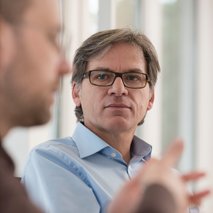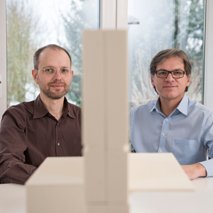Will our living space have to satisfy different requirements in future?
Kai Uetrecht: In the course of our lives we have to deal with constantly changing basic conditions, and the requirements we have of our home change accordingly. We need intelligently used space. It's spatial quality we want. People have a need to experience the space physically – the proportions of the room, the light or the view of the surroundings. A piece of furniture is just the thing for promoting, defining and structuring spatial quality. Many products just can't do that. Especially not in the bathroom.
The bathroom furniture system rc40 celebrated its premiere at the ISH 2005. What was it that prompted you and Burgbad to take rc40's development to the next level?
Ulli Finkeldey: With any product we've designed, it's very rare for us to arrive at a final result because product development is a continuous process. You don't just abandon that process once the product has been presented. The development of rc40 was a major step, something totally new – for Burgbad too: it was the evolution of a solitaire piece of bathroom furniture into a complex bathroom furniture system. That was something we all had to learn during the initial stages.
Kai Uetrecht: A lot of new ideas couldn't be implemented in the first step of the process, especially those that involved a holistic development of the space. And that – starting with the smallest of rooms in a sophisticated urban apartment all the way to big, fascinating spaces – is where we see a need for rc40 to offer solutions that can be integrated into these spaces three-dimensionally.
What's the idea behind this next step into the third dimension?
Kai Uetrecht: We're creating island solutions or usage areas, and that allows us to give the space a completely new quality – it permits a new quality of life as well. We can now provide the architect with stimulating ideas for presenting the bathroom to his client from a totally different perspective. In our opinion, rc40 can be used not just to create space but to save space as well, so it always results in a contemporary organisation of the space.
Ulli Finkeldey: We're firmly convinced that the basis of rc40 will stand the test of time. The product is so serene and so coherent that there's no need to make any changes to its form.
What does the rc40 system mean for how we'll be living in the future?
Ulli Finkeldey: To start with the furniture was turned into space, now the space is meant to turn into furniture. For us, not even the walls count any more – we want to give the wall content, an integrative function, if you like. That's rc40's new approach. It's a platform for functional and emotional living. Normally the wall only performs a static function. With rc40, we're giving the wall an integrative function.
Kai Uetrecht: We can create cosiness via the furniture, but we can also structure the spaces via a function – as is the case with sliding doors, for instance. rc40 caters to modern architecture's development towards more open living areas that merge with one another, just as it promotes the intelligent usage of limited space, regardless of whether that space is new or renovated.
How does that work?
Ulli Finkeldey: The collection has certainly got what it takes to overcome current spatial limits: flexible dimensions, wall-high panel systems and a wide range of integrable modules like the washstand, bathtub, mirrors and mirror cabinets, not to mention surfaces that can be given a totally uninterrupted look and come in a wide choice of finishes ranging from wood all the way to lacquer.
Kai Uetrecht: Like a box full of building blocks or Lego, rc40 is meant to give creative planners the possibility of using the furniture collection to create new spaces.
And how did you achieve this flexibility?
Kai Uetrecht: The furniture is mounted on a steel skeleton, which gives it sufficient stability to hold things like the washstand, mirror cabinet, wall-hung toilet or shower toilet.
Ulli Finkeldey: Burgbad also collaborates with prominent suppliers of pre-wall systems like Geberit and Viega, so the plumbers can rely on their experience with systems they've already learned about and the practical knowledge they've gained in their day-to-day work.
Doesn't design also mean reducing things to the essentials?
Kai Uetrecht: Yes, you're quite right. rc40 also conveys the serenity needed in order to make other products, furniture or people the focus of attention. When you see it, you realise something's different than usual. I honestly think that, when they're looking at rc40, a lot of people don't consciously realise how much creative thought and effort has gone into the system. The concealed trap, for instance, is totally invisible. But it's only because of details like this that rc40 can achieve such unprecedented clarity. I think that's also what accounts for the fascination of this space system.
Aren't comprehensive product systems like this too complex for the user?
Ulli Finkeldey: No, nowadays people view innovations as a matter of course and transport them into their own world. When they see an rc40 configuration with a bathtub, they realise how variable it is and intuitively transfer the solution to their own needs – they might translate it into a configuration with a shower, for instance.
Kai Uetrecht: But more than anything else, rc40 gives the planner a powerful tool that allows him to develop his creative potential and give the design his own signature whilst working within the framework of a professional and complex system. And that's in the interests of the future user too, of course.
Ulli Finkeldey: I believe we're living in an age that calls for very individual product systems – and rc40 is precisely that kind of individual product. And of course individuality and integration are the standard Burgbad has to meet, the challenge it has to rise to. A bathroom furniture manufacturer has to have sufficient systems expertise to translate the users' needs into a viable product – so as to replace the bathtub with a shower in the example I mentioned earlier, for instance. When it comes to rc40, Burgbad has a great deal of experience to fall back on.
So your product developments focus on the human users?
Ulli Finkeldey: Yes, of course. Rather than dictating the way the product should be used, we offer the user a variety of open-ended usage possibilities that he can define for himself.
Kai Uetrecht: If somebody sings in the shower and feels good while he's using it, we've done a good job. But it's not just purely formal values that are responsible for that – the reason for his sense of wellbeing lies in the serenity, practicality and generosity of rc40.
Can rc40 be used in other rooms too?
Ulli Finkeldey: Why not? Obviously all the functional details are geared towards the bathroom. But if we supplied a cutlery tray with it, there's no reason why rc40 couldn't be used in the kitchen as well. However, the neutrality of the forms opens up other usage possibilities as well – like walk-in wardrobes or links between the bathroom and bedroom. With rc40, we wanted to create something that is both life and space – living space in the truest sense of the word. That's what we set out to do, and we think that's precisely what the result achieves. We developed the furniture for people; in fact, we even want it to give its users moments of happiness – for a long time to come.
Information about Nexus Product Design you will find here.
Interview: Frank A. Reinhardt










